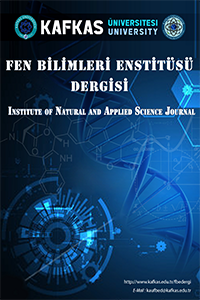Optimization with Taguchi Method of Laser Parameters Necessary for Smooth Groove Bottom in ZAMAK 5
Bu çalışmada uzun yıllardır sektörde sıklıkla kullanılan ZAMAK 5 plakalar üzerinde Nd:YAG lazer ile oluk şeklinde kaviteler oluşturulmuştur. Oluşturulan kavite tabanının homojen bir derinliğe sahip olması için gerekli lazer parametreleri optimize edilmiştir. Kullanılan Nd:YAG lazerin ışın çapı, lazer enerjisi, koruyucu gaz tipi ve tek atım süresinin kavite pürüzlülüğü üzerindeki etkileri optimize edilmeye çalışılmıştır. ANOVA tablosuna göre, spot çapı, tek spot enerjisi, ortam gazı türü ve tek darbe spotu için optimum parametreler sırasıyla “580µm, 7J, Nitrogen, 7 ms'dir. Taguchi yöntemi, kullanılan lazer parametrelerinin istenilen yüzeyin elde edilmesinde ne kadar etkili olduğunu da göstermektedir. Kullanılan ortam gazının bu çalışmada en önemli parametre olduğu sonucuna varılmıştır. Etki oranı %74.90 olarak elde edilmiştir. Daha sonra sırasıyla lazer spot çapı ve atım enerjisi ve son olarak atım süresi daha az etkili parametrelerdir.
Anahtar Kelimeler:
Lazer işleme, ZAMAK5, Nd:YAG Lazer, Optimizasyon, Lazer Ablasyon, Taguchi Metodu
Optimization with Taguchi Method of Laser Parameters Necessary for Smooth Groove Bottom in ZAMAK 5
In this study, groove-shaped cavities were created with Nd: YAG laser on ZAMAK 5 plates, which have been used frequently in the industry for many years. The necessary laser parameters have been optimized so that the created cavity floor has a homogeneous depth. The effects of the beam diameter, laser energy, shielding gas type, and duration of the single pulse of Nd: YAG laser used on the roughness in the cavity were tried to be optimized. It was used for optimization. According to the ANOVA table, the optimum parameters are “580µm, 7J, Nitrogen, 7 ms for spot diameter of spot, the energy of single spot, type of ambient gas and a spot of single pulse respectively. The Taguchi method also indicates how effective the laser parameters used are in obtaining the desired surface. It has been concluded that the ambient gas used is the most important parameter in this study. The effect rate was obtained as 74.90 %. Then, laser spot diameter and pulse energy and lastly pulse duration are fewer effective parameters respectively.
Keywords:
Laser machining, ZAMAK5, Nd:YAG Laser, Optimization, Laser Ablation, Taguchi Method,
___
- Etsion I. (2005). State of the Art in Laser Surface Texturing, Transactions of the ASME, (127) 248-253.
- Hirose T., Shiba K., Ando M., Enoeda M., Akiba M. (2006). Joining technologies of reduced activation ferritic/martensitic steel for blanket fabrication, Fusion Engineering and Design (81), 645–651.
- Holmberg K., Matthews A. and Ronkainen H. (1998). Coatings tribology—contact mechanisms and surface design. Tribology International vol. 31, pp. 107–120, 1998.
- Kubiak K.J. and Mathia T.G. (2009). Influence of roughness on contact interface in fretting under dry and boundary lubricated sliding regimes. Wear, (267), 315–321.
- Kubiak K.J., Wilson M.C.T., Mathi T.G., Carval Ph. (2011) Wettability versus roughness of engineering surfaces, Wear. vol (271). 523–528.
- Menezes P. L., Kishore, S. Kailas V. (2009). Influence of surface texture and roughness parameters on friction and transfer layer formation during sliding of aluminium pin on steel plate, Wear (267), 1534–1549.
- Perveen A. and Feng L. (2017) Effect of Texturing on the Friction Characteristic of Carbide and Steel Material by Grinding Process. Materials Science Forum, (887), 83-88.
- Raeesi B., Morrow N. R., Mason G. (2013). Effect of surface roughness on wettability and displacement curvature in tubes of uniform cross-section, Colloids and Surfaces A: Physicochem. Eng. Aspects, (436), 392-401.
- Somekaw H. and Higashi K. (2003). The Optimal Surface Roughness Condition on Diffusion Bonding. Materials Transactions, (44), 1640-1643.
- Vojtech D., Kubasek J., Šerak J., Novak P. (2011). Mechanical and corrosion properties of newly developed biodegradable Zn-based alloys for bone fixation. Acta Biomaterialia, (7), 3515–3522.
- Zhang W., Du Y., Huo W., Hu J., Lu J., Zhao X., Zhang L., Zhang Y. (2019). Microstructure and Mechanical Properties of Zamak 3 Alloy Subjected to Sliding Friction Treatment. Metallurgical and Materials Transactions, (50A), 5888-5895.
- ISSN: 2587-2389
- Yayın Aralığı: Yılda 2 Sayı
- Başlangıç: 2008
- Yayıncı: Kafkas Üniversitesi
Sayıdaki Diğer Makaleler
Likenlerde Ağır Metal Alınma Mekanizmaları
Analitik Fonksiyonların Belirli Bir Sınıfı İçin Fekete-Szegö Problemi Üzerine
AAS ve Bulanık AAS Yöntemleri ve Bir Uygulama
Bağlantılı Liste Algoritmasını Kullanarak Çevrimiçi Öğrenme Ortamı Tasarlama
Optimization with Taguchi Method of Laser Parameters Necessary for Smooth Groove Bottom in ZAMAK 5
